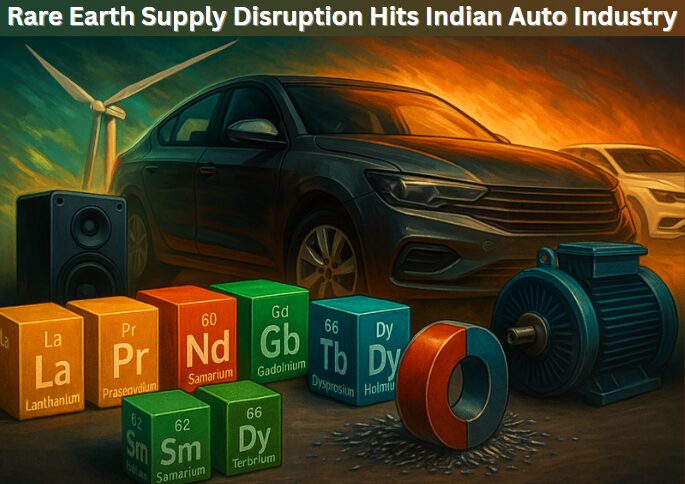Quick Look: What You Need to Know
- China has made it much harder to export rare earth magnets, which India relies on heavily.
- These magnets are tiny but essential for cars—EVs and even regular petrol/diesel ones.
- Big names like Bajaj Auto and TVS are already warning: production might stop as early as July.
- India is now racing to find alternatives, from talking to China to developing our own alternatives.
Introduction:
What do a high-tech electric vehicle and a basic Bluetooth speaker have in common? Both need something you’ve probably never heard of normally: rare earth magnets.
Now, imagine this—your favorite bike or car manufacturer in India suddenly can’t make vehicles. Not because of steel shortages. Not because of labor strikes. But because China won’t send us these tiny, powerful magnets anymore.
Sounds dramatic? That’s exactly what’s unfolding right now.
So, What Exactly Are Rare Earths?
Rare earth elements (REEs) are a group of 17 unique metals that make our modern tech run—quietly, invisibly, efficiently and effectively. They’re crucial in car motors, especially electric vehicles (EVs), and even in regular internal combustion engine (ICE) cars for parts like:
- Engine sensors
- Steering systems
- Infotainment speakers
- Fuel injection systems
The stars of this metallic crew are Neodymium, Dysprosium, and Praseodymium—all used to make rare earth permanent magnets.
| Component | Where It’s Used |
|---|---|
| Rare Earth Magnets | EV motors, ICE sensors, audio systems, steering |
| Neodymium + Praseodymium | For strong, compact, high-efficiency magnets |
| Dysprosium | Boosts magnet heat-resistance in high-power systems |
What’s Going Wrong?
In April 2025, China changed the rules of the game. As part of its retaliation to U.S. tariffs, China added more hurdles to exporting rare earth magnets—even to India. Now, if Indian companies want to import magnets, they must:
- Prove they’re not using them for military purposes
- Get clearance from India’s DGFT (Directorate General of Foreign Trade) and Ministry of External Affairs
- Get additional clearance from the Chinese embassy
- Wait for final export permission from China’s commerce ministry
This isn’t just paperwork—it’s a full-blown logistical nightmare that hampers a lot!
And the consequences? Supplies are drying up. Bajaj Auto and TVS have already said that if the situation doesn’t improve, vehicle production could hit a wall by July. And it’s not just EVs—even petrol and diesel vehicles will be affected.
What’s India Doing About It?
There’s no magic fix, but there’s movement.
First, the government is planning to send a delegation of auto industry leaders to China. Their goal? Try to convince officials there to resume easier exports.
Second, Indian companies are now scrambling for alternatives.
Take Sona Comstar, for example. They’re working on new motors that use ferrite magnets, which are cheaper, made in India, and don’t depend on imports. Sounds great, right?
Well, not quite.
These alternatives are less efficient, bulkier, and not quite ready for high-performance vehicles yet. As Sona’s CEO Vivek Vikram Singh put it:
“The tech is solid, but it still doesn’t meet the efficiency we need.”
The Bigger Picture
This rare earth crisis is more than just a temporary hindrance—it’s a wake-up call.
India’s auto sector has been thriving. But behind the scenes, it’s heavily dependent on one country for a small but critical component. That’s a risky bet in today’s unpredictable world.
Now is the time to rethink that strategy.
- Invest in R&D
- Build local supply chains
- Develop new materials and tech that don’t rely on imports
Because if we don’t? This won’t be the last time a hidden mineral decides the fate of our roads.

